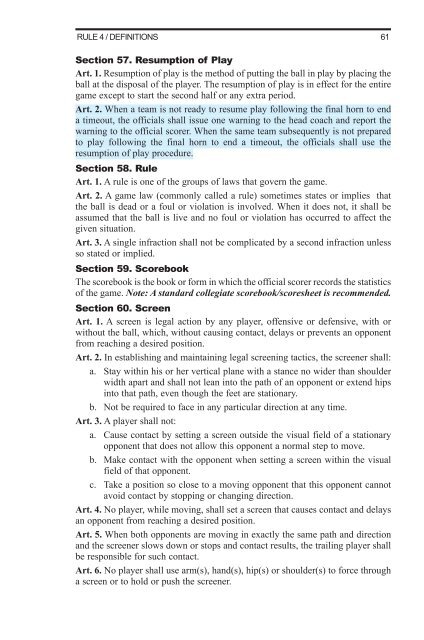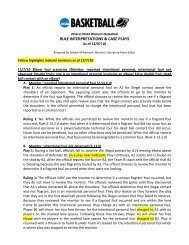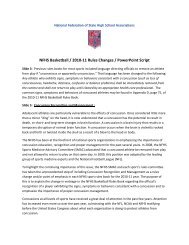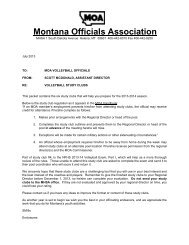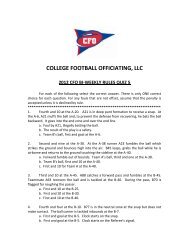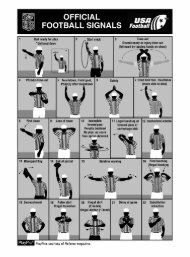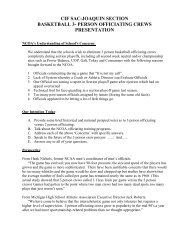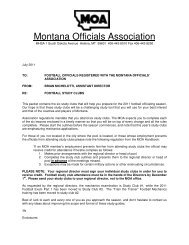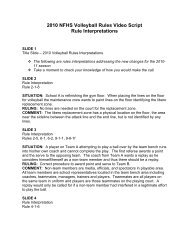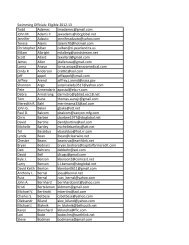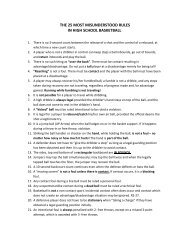2011-12 AND 2012-13 MEN'S AND WOMEN'S RULES - NAIA
2011-12 AND 2012-13 MEN'S AND WOMEN'S RULES - NAIA
2011-12 AND 2012-13 MEN'S AND WOMEN'S RULES - NAIA
Create successful ePaper yourself
Turn your PDF publications into a flip-book with our unique Google optimized e-Paper software.
RULE 4 / DEFINITIONS61<br />
Section 57. Resumption of Play<br />
Art. 1. Resumption of play is the method of putting the ball in play by placing the<br />
ball at the disposal of the player. The resumption of play is in effect for the entire<br />
game except to start the second half or any extra period.<br />
Art. 2. When a team is not ready to resume play following the final horn to end<br />
a timeout, the officials shall issue one warning to the head coach and report the<br />
warning to the official scorer. When the same team subsequently is not prepared<br />
to play following the final horn to end a timeout, the officials shall use the<br />
resumption of play procedure.<br />
Section 58. Rule<br />
Art. 1. A rule is one of the groups of laws that govern the game.<br />
Art. 2. A game law (commonly called a rule) sometimes states or implies that<br />
the ball is dead or a foul or violation is involved. When it does not, it shall be<br />
assumed that the ball is live and no foul or violation has occurred to affect the<br />
given situation.<br />
Art. 3. A single infraction shall not be complicated by a second infraction unless<br />
so stated or implied.<br />
Section 59. Scorebook<br />
The scorebook is the book or form in which the official scorer records the statistics<br />
of the game. Note: A standard collegiate scorebook/scoresheet is recommended.<br />
Section 60. Screen<br />
Art. 1. A screen is legal action by any player, offensive or defensive, with or<br />
without the ball, which, without causing contact, delays or prevents an opponent<br />
from reaching a desired position.<br />
Art. 2. In establishing and maintaining legal screening tactics, the screener shall:<br />
a. Stay within his or her vertical plane with a stance no wider than shoulder<br />
width apart and shall not lean into the path of an opponent or extend hips<br />
into that path, even though the feet are stationary.<br />
b. Not be required to face in any particular direction at any time.<br />
Art. 3. A player shall not:<br />
a. Cause contact by setting a screen outside the visual field of a stationary<br />
opponent that does not allow this opponent a normal step to move.<br />
b. Make contact with the opponent when setting a screen within the visual<br />
field of that opponent.<br />
c. Take a position so close to a moving opponent that this opponent cannot<br />
avoid contact by stopping or changing direction.<br />
Art. 4. No player, while moving, shall set a screen that causes contact and delays<br />
an opponent from reaching a desired position.<br />
Art. 5. When both opponents are moving in exactly the same path and direction<br />
and the screener slows down or stops and contact results, the trailing player shall<br />
be responsible for such contact.<br />
Art. 6. No player shall use arm(s), hand(s), hip(s) or shoulder(s) to force through<br />
a screen or to hold or push the screener.


